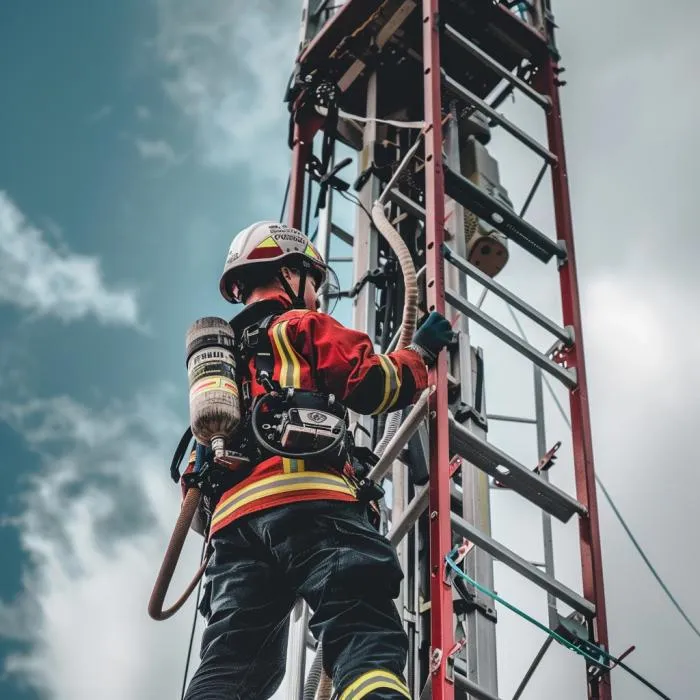
The Role of DAS in Enhancing Wireless Coverage for First Responders
In emergency situations, effective communication is paramount for first responders to perform their duties efficiently and safely. Distributed Antenna Systems (DAS) play a crucial role in ensuring that first responders have reliable wireless coverage, enabling seamless communication within buildings and across complex structures. At DAS University, we emphasize the importance of DAS in enhancing wireless coverage for first responders, ensuring they can communicate effectively during critical moments. This blog post explores the benefits of DAS for first responders, the challenges it addresses, and best practices for implementation.
Understanding Distributed Antenna Systems (DAS)
A Distributed Antenna System (DAS) is a network of spatially separated antenna nodes connected to a common source. These systems enhance wireless signal coverage within buildings, ensuring that communication signals reach every corner, including areas that are traditionally hard to cover such as basements, stairwells, and underground facilities.
Importance of DAS for First Responders
Reliable Communication in Emergencies
Seamless Connectivity: DAS ensures that first responders have continuous and reliable communication throughout a building, including in areas with weak or no signal.
Critical Coordination: Reliable communication is essential for coordinating rescue efforts, providing medical assistance, and managing evacuation procedures during emergencies.
Compliance with Public Safety Standards
Building Codes: Many jurisdictions require buildings to have in-building wireless systems that support public safety communication. DAS helps buildings comply with these regulations, ensuring occupant safety and avoiding legal penalties.
Fire Codes: DAS systems often meet specific fire code standards, ensuring they function correctly during a fire emergency and aiding firefighters in their response efforts.
Enhanced Coverage in Complex Environments
Signal Penetration: DAS improves signal penetration through thick walls and other structural barriers, ensuring that first responders can communicate effectively in all areas of a building.
Eliminating Dead Zones: By strategically placing antennas, DAS eliminates dead zones and ensures consistent signal strength throughout the entire structure.
Support for Multiple Agencies
Interoperability: DAS can be configured to support multiple frequencies and communication protocols, ensuring interoperability between different emergency services such as fire, police, and medical responders.
Coordination: Enhanced communication facilitates better coordination between different agencies, leading to more effective and efficient emergency response.
Challenges Addressed by DAS
Building Materials and Design
Signal Obstruction: Modern building materials such as concrete, steel, and low-emissivity glass can obstruct wireless signals. DAS mitigates this by enhancing signal strength and coverage.
Complex Layouts: Large buildings with multiple floors and complex layouts can create communication dead zones. DAS ensures comprehensive coverage throughout the entire structure.
Network Congestion
High Traffic: During emergencies, communication networks can become congested with high traffic volumes. DAS provides dedicated channels for emergency responders, reducing congestion and ensuring reliable communication.
Power Outages
Backup Power Solutions: DAS can be equipped with backup power sources, such as batteries or generators, to maintain communication capabilities during power outages caused by disasters.
Best Practices for Implementing DAS for First Responders
Conduct a Comprehensive Site Survey
Assessment: Perform a detailed site survey to map out the building’s layout, identify signal obstruction points, and determine areas with weak or no coverage.
Customized Plan: Use the survey data to create a customized DAS solution that addresses the unique challenges of the building.
Engage with Local Authorities
Collaboration: Work closely with local fire departments, police, and other emergency services to understand their communication needs and ensure the DAS meets all public safety standards.
Compliance: Ensure the DAS complies with local building codes, fire codes, and public safety communication regulations.
Design for Redundancy and Resilience
Redundant Pathways: Design the DAS with redundant pathways to ensure that if one part of the system fails, communication can continue through alternate routes.
Backup Power: Implement backup power solutions to ensure continuous operation during power outages and other disruptions.
Regular Testing and Maintenance
Routine Checks: Schedule regular testing and maintenance to ensure the DAS remains operational and effective. Conduct emergency drills to test the system’s performance under simulated disaster conditions.
Proactive Monitoring: Implement real-time monitoring tools to continuously track the performance of the DAS, allowing for prompt issue resolution and continuous optimization.
Training and Education
First Responder Training: Provide training for first responders on the proper use and maintenance of the DAS. Ensure they are familiar with the system’s capabilities and limitations.
Building Occupant Awareness: Educate building occupants about the importance of DAS and how it supports emergency communication. Ensure everyone knows how to respond and communicate during emergencies.
Real-World Applications of DAS for First Responders
Hospitals and Healthcare Facilities
Critical Communication: In healthcare settings, reliable communication is essential for coordinating patient care and emergency responses. DAS ensures that medical personnel and first responders can communicate effectively throughout the facility.
Commercial and Residential High-Rises
Fire Safety: High-rise buildings pose unique challenges for emergency communication. DAS provides reliable coverage from the ground floor to the top, enabling firefighters and other responders to maintain communication during emergencies.
Educational Institutions
Campus Safety: Schools and universities benefit from DAS by ensuring that security personnel and first responders can communicate effectively across campus, enhancing safety and emergency response capabilities.
Transportation Hubs
Continuous Communication: Airports, train stations, and other transportation hubs require robust communication systems to manage emergencies and coordinate responses. DAS ensures reliable communication in these expansive areas.
Case Study: Successful DAS Implementation for First Responders
Consider a large metropolitan hospital that faced significant communication challenges due to its complex layout and thick building materials. By implementing a DAS solution, the hospital enhanced its emergency response capabilities, ensuring reliable communication for medical personnel and first responders. During a recent emergency, the hospital was able to maintain continuous communication, coordinate efforts effectively, and provide timely patient care, demonstrating the life-saving potential of DAS technology.
Conclusion
Distributed Antenna Systems (DAS) are essential for enhancing wireless coverage for first responders. By providing comprehensive coverage, supporting public safety networks, maintaining connectivity during power outages, and reducing network congestion, DAS enhances the ability of first responders to coordinate and perform their duties effectively. At DAS University, we are dedicated to educating professionals on the critical role of DAS in public safety and equipping them with the knowledge to implement and maintain these systems. Join us to learn more about enhancing safety through advanced communication solutions and become a leader in public safety enhancement.



